Pipedreams Euro-Tour
April 28 - May 11, 2006
Villingen (Benedictine Church of Saint George)
| |
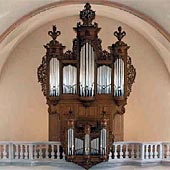 |
When the Lutheran Dukedom Württemberg disbanded their monastery in Saint Georgen, the Benedictine monks settled in Villingen in 1566. In the eighteenth century, a new Baroque abbey church with monastery buildings was built under the direction of the famous architect Michael Thumb, finally completed with the representative tower in 1756.
In the summer of 1752, Johann Andreas Silbermann built a new organ for the Benedictine Church of Saint George in Villingen. The monastery’s musical culture must have been of a very high level, because it was dominating the city’s music program. But, similar to the fate of the Saint Blasien Silbermann organ, due to the secularization the new owner of the church, the Grand Duke of Baden, gave this organ to the Protestant City Church in Karlsruhe in 1807. Here, it was rebuilt several times and, eventually, vanished.
The present organ is a reconstruction of the 1752 Silbermann organ, built in 2002 by the organ company Gaston Kern from Strasbourg, with 36 stops on three manuals and pedal.
Links and resources
Radolfzell (Minster)
The present church was built between 1436 and 1555, nothing is left from the previous Roman church building. The spire of the tower has been added in 1903, it is the tallest church tower in the region around the Lake Constance. In the 18th century, several Baroque elements were added in the church’s interior: The stucco ceiling in the nave (1713), the Rosary altar from David Zuern (1648) and a high-altar, replaced by a Neo-Gothic altar in 1897 as a counterpiece of the Neo-Gothic organ facade on the west gallery. A specialty is the Hausherren Chapel, built as a separate Baroque “inlay” inside the sanctuary. The church underwent a complete renovation in 1982-1998.
Built in 1903 by Wilhelm Schwarz, from Ueberlingen (II/P/27, with electro-pneumatic actions and cone chests), the organ was radically modified several times and was also supplied with a massive caseless 16′-front.
| |
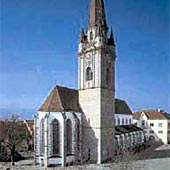 |
In 1997, the new organ design of the Moench organ company, from Ueberlingen, was built by using the majority of the Schwarz pipework from 1903. This included all mutation and reed stops as well as providing the intensifying effect of two swell organs (manuals II and III). The new organ, with all mechanical actions, is now based on the reliable slider chest system. The design took into account the need for more space and air of those original pipes voiced for cone chests. Because of lightning hazard (the church’s tower is the tallest in the region, see above), electronic parts get always damaged in the Minster. For this reason, it was decided to refrain from the inclusion of modern console techique, such as electronic piston system etc.
The construction of the new organ took a surprising turn when the entire front case of the 1903 Schwarz organ was rediscovered in the attic of the parish house. With the help of historic photos, a complete reconstruction of the organ base was accomplished. With the new enlarged specification (III/P/40), the organ has received back its typical German Romantic sound.
Links and resources
Überlingen (Minster)
The Minster of Saint Nikolaus dominates above the roofs of the historic city center. Following a three-nave basilica from the 12th century, the building of today’s basilica started with the choir (14th century) and the nave (from 1425), the North tower was completed in 1494, with a Late Gothic spire (1574). The South tower has never been completed, it houses the largest middle-age bell of the region (1444), the North tower houses seven historic bells: d′ (1585) - e-flat′ (1741) - g-flat′ (1609) - b′ (1577) - f″ (15. Jh.) - c′′′ (15. Jh.) - d-flat′′′ (1714). The Rosary Altar (same artist) was completed in 1631, the pulpit from 1551, the choir grill from 1754, tabernacle from 1611.
| |
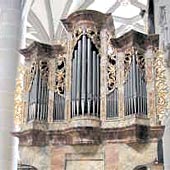 |
First organs are dating back into the 15th century, enlarged in 1508, replaced by a new instrument 1548. In 1774, Riepp’s Tabernacle Organ from Salem was bought and installed in Ueberlingen. After a new west gallery was erected in 1887, organbuilder Wilhelm Schwarz placed 1888 a new organ here. In 1926, this instrument was modernized and enlarged from 30 to 42 speaking stops by Schwarz. Today’s organ on the west gallery has been built 1968 by the local firm of Moench und Pfaff (formerly Schwarz) and was enlarged in 1996 by a stopped Pedal-32′. At the same time, the old combination system was replaced by a modern setter piston system.
Links and resources
The day to day…

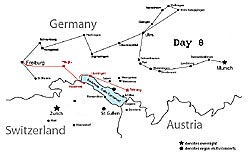
 Notes from the Road - travel log, day 8
Notes from the Road - travel log, day 8 Michael Barone’s pictures from the tour
Michael Barone’s pictures from the tour Images from Saint George’s, Villingen
Images from Saint George’s, Villingen Images from Radolfzell Minster
Images from Radolfzell Minster Images from Überlingen Minster
Images from Überlingen Minster Day 7 - Schramberg & Freiburg
Day 7 - Schramberg & Freiburg Day 9 - Weingarten & Wiessenau
Day 9 - Weingarten & Wiessenau Main Tour Page
Main Tour Page
 Notes from the Road - travel log, day 8
Notes from the Road - travel log, day 8 Images from Saint George’s, Villingen
Images from Saint George’s, Villingen City of Villingen
City of Villingen Find detailed organ specifications in our Tour Book
Find detailed organ specifications in our Tour Book
 Notes from the Road - travel log, day 8
Notes from the Road - travel log, day 8 Images from Radolfzell Minster
Images from Radolfzell Minster View of city from Lake Constanze
View of city from Lake Constanze Images of Radolfzell
Images of Radolfzell Find detailed organ specifications in our Tour Book
Find detailed organ specifications in our Tour Book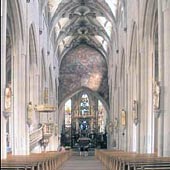

 Notes from the Road - travel log, day 8
Notes from the Road - travel log, day 8 Images from Überlingen Minster
Images from Überlingen Minster Überlingen website
Überlingen website Überlingen, Saint Nikolaus - Wikipedia
Überlingen, Saint Nikolaus - Wikipedia Find detailed organ specifications in our Tour Book
Find detailed organ specifications in our Tour Book

